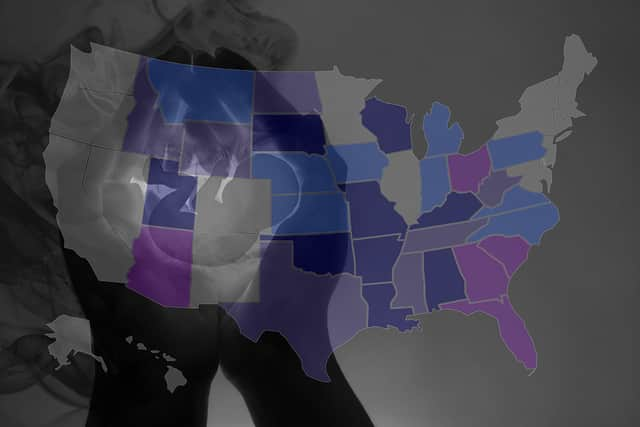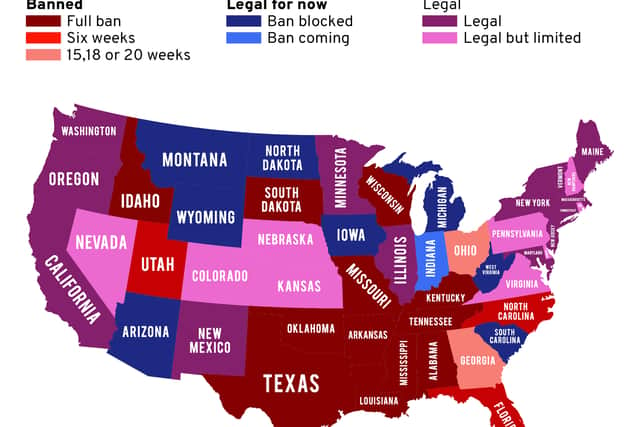Where is abortion illegal in US? Which states have banned pregnancy termination as Roe v Wade law overturned
This article contains affiliate links. We may earn a small commission on items purchased through this article, but that does not affect our editorial judgement.
and live on Freeview channel 276
A legal expert has warned that it it “may take generations to completely restore abortion rights” after a landmark ruling saw US states being given the power to decide whether or not to allow women to terminate their pregnancies.
It is expected that abortions may be banned in up to half of the 50 states in the United States because of the new ruling, which happened in a case called Dobbs v Jackson Women’s Health.
Advertisement
Hide AdAdvertisement
Hide AdUntil the supreme court ruling, which took place on Friday 24 June, abortion had been a constitutional right across America for almost 50 years because of a previous ruling in the Roe v Wade case.
So why was the Roe v Wade decision overturned - and where is abortion now illegal in the US? Here’s what you need to know.


Is abortion illegal in the US?
No, abortion is not illegal across the whole of the United States.
There are 50 states in the US, and each state will now be able to make their own decision about whether or not to allow the termination of pregnancy.
Advertisement
Hide AdAdvertisement
Hide AdThis new state power comes after the US Supreme Court abolished the constitutional right to abortion on Friday 24 June almost 50 years after the right was established, and after the historic overturning of court case Roe v Wade.
It is expected to lead to abortion bans in about half of the states.
It does, however, remain legal to travel out of states to get an abortion.


Where is abortion now banned is the US?
Terminating a pregnancy was made illegal in multiple US states within hours of Roe v Wade being overturned, and more states have since also banned abortions.
Advertisement
Hide AdAdvertisement
Hide AdAs of 1 September, early all abortions have now been prohibited in various states after the 24 June ruling, according to the Guttmacher Institute.
These are all the US states where abortion is already banned or restricted:
- Alabama
- Arkansas
- Idaho
- Kentucky
- Louisiana
- Mississippi
- Missouri
- North Dakota
- Oklahoma
- South Dakota
- Tennessee
- Texas
- Wisconsin
Ohio and Georgia have six week bans in effect now also, making most abortion inaccessible. It does, mean, however, that if women are fewer than six weeks pregnant they can still get an abortion in these states. Currently, Florida also bans abortion after 15 weeks.
These are all the states where abortion will be, or is expected to be, banned or retricted in the coming days weeks and months:
- Wyoming
- Arizona
- Indiana
- Michigan
Advertisement
Hide AdAdvertisement
Hide AdVisit the Guttmacher Institute interactive map for more information about the rules in each state.
Among the first states to outlaw almost all abortions after the ruling was Utah where an abortion ban came into effect on the evening of 24 June.
Utah’s Republican state senator Daniel McCay said it would be wrong for Utah women to seek abortions in neighbouring states but added that he had no immediate plans to stop them from doing so.
Where is abortion still legal in the US?
Not every state in the US has reacted to the ruling by banning the termination of pregnancy.
Advertisement
Hide AdAdvertisement
Hide AdIn fact, multiple states vowed to protect the right to abortion after the decision was declared.
These are the states where abortion remains legal:
- Alaska
- California
- Colorado
- Connecticut
- Delaware
- Hawaii
- Illinois
- Kansas
- Maine
- Maryland
- Massachusetts
- Minnesota
- Nevada
- New Hampshire
- New Jersey
- New Mexico
- New York
- Oregon
- Rhode Island
- Vermont
- Washington
In these states, laws protect abortion either up to viability or throughout pregnancy.
In Washington DC, mayor Muriel Bowser, responded by declaring it “a pro-choice city”, but warned that as a district, not a state, it was now vulnerable because Congress had oversight of it.
The Democratic governors of California, Washington and Oregon have all also vowed to protect abortion rights and help women who travel to the west coast from other states for abortions.
Advertisement
Hide AdAdvertisement
Hide AdThey issued a “multi-state commitment” and said they would collaborate to defend patients and medical professionals providing abortions as they anticipated an influx of people seeking abortions.
They also pledged to “protect against judicial and local law enforcement cooperation with out-of-state investigations, inquiries, and arrests” into abortions in their states.
Is the law on abortion unclear in any US states?
At the time of writing, the stance on abortion in some US states remained unclear.
Lawmakers in some states have showed an interest in restricting abortion, while others want to protect abortion rights in the short term.
Advertisement
Hide AdAdvertisement
Hide AdIn some states, pre-Roe v Wade laws that prohibited abortion before the 1973 decision could be enforced again, but this decision has not yet been made.
These are the states where the law remains unclear:
- Iowa
- Montana
- Nebraska
- Pennsylvania
- Virginia
Visit The New York Times tracker for more information about the rules in each state.
What is Roe v Wade?
Roe v Wade was a landmark Supreme Court case, which led to abortion being made legal in the United States in 1973.
Each state, however, still had its own set of legal guidelines for abortion, with some being far more restrictive than others.
Advertisement
Hide AdAdvertisement
Hide AdThe decision gave women total autonomy to terminate a pregnancy during the first trimester, and allowed some state influence over abortions in the second and third trimesters.
The Supreme Court’s 7-2 decision at the time was based partly on the 14th Amendment’ of US Constitution, the right to privacy, that protects a woman’s right to access abortion.
The ruling effectively revoked laws that banned the procedure outright and sparked decades of debate over women’s bodies, the right to choose and the right to life.
Why was Roe v Wade overturned?
The court’s ruling in case Dobbs v Jackson Women’s Health in the Supreme Court on Friday 24 June overturned the earlier ruling made in Roe v Wade.
Advertisement
Hide AdAdvertisement
Hide AdDobbs v Jackson Women’s Health Organization marked the first major abortion rights challenge in front of the new Conservative supermajority on the court with its three newest justices.
In an unprecedented leak draft opinion from conservative Justice Samuel Alito, which was first reported by Politico, he said “It is time to heed the Constitution and return the issue of abortion to the people’s elected representatives”.
The court’s decision on Friday 24 June was effectively the same opinion from the draft.
Can the Roe v Wade overturning be challenged?
The opportunities to challenge the justices’ ruling or re-present constitutional law arguments based on equal rights are for now limited.
Advertisement
Hide AdAdvertisement
Hide AdHarvard constitutional law professor Lawrence Tribe, who has described the decision as “unprincipled”, told the Guardian: “We’re in for a long, tangled, chaotic and, in terms of human suffering, horribly costly struggle.
He added that it may take generations to completely restore abortion rights but there may be opportunities to minimise the effects of the ruling.
The ruling may force pregnant women in certain states, where abortions are now banned, to carry their pregnancies to term unless they can travel to some states which have abortion protections in place.
What were the abortion rules in the US prior to Roe v Wade?
Prior to Row v Wade, 30 states had banned abortion outright, and while all 50 states complied with the federal ruling at the time to decriminalise abortion, many enacted laws limiting abortion as much as legally allowed.
Advertisement
Hide AdAdvertisement
Hide AdBefore the Dobbs v Jackson rulling, state laws banning or severely restricting abortion access fell into three broad categories.
These were:
- Trigger bans which banned abortion under most circumstances and go into effect once again now Roe v Wade has been overruled
- Bans which are old laws that are still on the books that could now be enforced
- More recently passed laws that limit abortion to an early gestational age or ban it totally.
Comment Guidelines
National World encourages reader discussion on our stories. User feedback, insights and back-and-forth exchanges add a rich layer of context to reporting. Please review our Community Guidelines before commenting.
